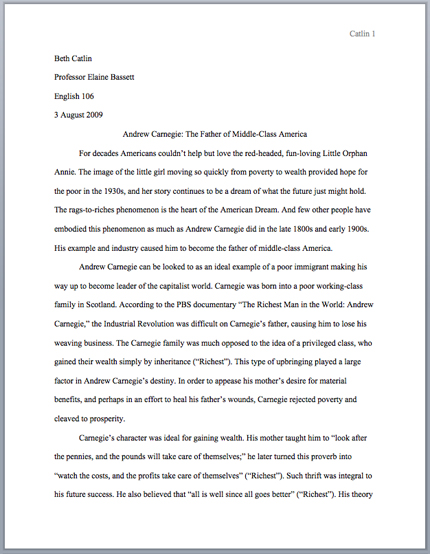
MLA Format Research Paper
MLA Research Paper Guide
The MLA research paper format is a commonly used style for research papers and essays. While it may seem complicated at first, it is actually a way to simplify your academic life. MLA (Modern Language Association) sets very specific rules to follow when formatting an essay or research paper, and once you learn the guidelines for the MLA paper format you can focus on more important issues – the topic of your paper, for instance – rather than the size of your margins or the rules for MLA in-text citation. As we take a look at the main points you may want to open your computer’s word processing program and set up an MLA template that has the basics set and ready to go each time you begin a new essay.
Page Navigation
MLA Research Paper Guide
MLA Format – Major Points
How Can We Help?
Get a Properly Formatted MLA First Page
MLA In-Text Citations for Your Research Paper
Your MLA Works Cited Page
What Should Your MLA Research Paper Outline Look Like?
Download Free MLA Research Paper Sample
Download Free MLA Paper Template
MLA Format – Major Points
Free MLA Paper Sample
(Click to enlarge)
Begin your MLA paper by setting a 1-inch margin on all sides of your page – top, bottom, left and right. Select a commonly used, legible font and set the font size at 12 point, double spaced. Next, format your MLA template to automatically insert page numbers. These should include your last name and the page number and should appear in the top right corner, 1/2 inch from the top of the page and aligned with the right margin. When you begin typing, indent the first line of each paragraph 1/2 inch from the left, and indent block quotes 1 inch from your margins.
You now have the basic framework in place for your MLA research paper format, so let’s move on to getting your thoughts on paper and ensuring others’ words are attributed accurately. Generally, quotes are identified by basic notations in the text of the paper with a more complete reference following in the works cited section.
How Can We Help
More writing help of the highest quality is available from ProfEssays.com, which delivers custom essays on time, even in emergency situations. Place your order now and a writing team can be assembled immediately and have an original paper ready to present to you in as little as 8 hours. Our focus is on offering the best service and price, and building long-lasting customer relationships by offering innovative, confidential services.
If you are new here, we say welcome! Take a look around, and let us know how can we help you. Our professional writers, researchers and editors are waiting to create a custom paper just for you as soon as you place an order. Our specialty is professional, original papers – all work is checked and cross-checked, edited and proofread, and scanned by the latest software to ensure it is plagiarism-free. Find out what we can do for you – order your paper today!
Get a Properly Formatted MLA First Page
MLA title page rules are actually very simple. MLA paper format does not make use of a cover page, but instructs authors to include a title block on the first page of the paper in the upper left corner. This MLA first page information follows the MLA research paper example that we already set up – font size, double spacing, etc. The title block contains four lines: your name, the professor’s name, course title and the date. Following that, the next line is the title of your paper, centered on the page, using standard rules for capitalizing titles. And directly below the title is where your paper begins.
MLA In-Text Citations for Your Research Paper
MLA paper citation is important because you must give proper credit to other authors and their ideas. MLA in-text citation includes notations in the text of your essay, with more complete reference information included later in the MLA Works Cited section.
For example, when quoting a book, article, etc., include the author’s name and the page number in your text: As Shakespeare said, “All the world’s a stage” (139). Or, you can place the author’s name in the parentheses with the page number: “All the world’s a stage” (Shakespeare 139).
If you are quoting an article that does not include the author’s name, use the title of the article and the page number, for example, (“Politicians and Philanthropy” 45). Long titles can be shortened, with the full title appearing in the Works Cited listing. MLA style calls for quotation marks around titles of shorter works, such as articles, and italic type for books, movies and other longer works.
Variations of these rules include adding the first initial if you are citing two authors with the same last name: (S. Weiss 35), (K. Weiss 221), and if quoting two articles by the same author, use the article titles in the citations, either following the author’s name, separated by a comma, or just the title itself if the author’s name is noted in the text.
Your MLA Works Cited Page
The MLA Works Cited page or MLA Bibliography includes the full reference information for the material that you have quoted or paraphrased. It follows the same format as the rest of your paper – margins, font, double spacing. The centered title at the top of the page should simply state, Works Cited. For items in the list that are longer than one line, use a hanging indent, that is, indent the second line. Alphabetize the entries by authors’ names, not by the order that they appeared in the text.
A basic book listing on your MLA Works Cited page is arranged as follows: author’s name (last name, first name); title of the book; edition number, if applicable; location; publisher; year; and medium (such as print or online sources). An article listing has the title of the article after the author’s name followed by the publication name and date and page numbers. References to online information should also include the preceding information, as well as the title of the Website; posting or revision dates or volume/issue number; publisher name; and the date you accessed the information. Here are some examples:
Ascher, Kate. The Heights: Anatomy of a Skyscraper. New York: Penguin Press, 2011. Print.
Carey, David and Morris, John E. King of Capital: The Remarkable Rise, Fall, and Rise Again of Steve
Schwarzman and Blackstone. New York: Crown Business, 2010. Print.
Sheeran, Thomas J. “Ohio Shale Drilling Spurs Job Hopes in Rust Belt.” Centre Daily Times, 27 Nov.
2011: A5. Print.
Brain, Marshall and Lamb, Robert. “How Nuclear Power Works.” HowStuffWorks.com, Discovery
Communications, 9 Oct. 2000. Web. 29 Nov. 2011.
What Should Your MLA Research Paper Outline Look Like?
Using the MLA research paper outline not only helps you organize your research paper information, but is often part of the required writing assignment as well. To outline your topic, begin by listing the main points using Roman numerals (I. II. III. IV. …). Divide each main point into subpoints and list these under the corresponding main heading, indenting and listing by capital letters (A. B. C. …). Continue to further detail each subpoint as well, with a greater indent and listing by lowercase letters. For more help, you can download an MLA research paper outline sample from ProfEssays.com.
 + 1-888-827-0150
+ 1-888-827-0150 + 44-20-3006-2750
+ 44-20-3006-2750













